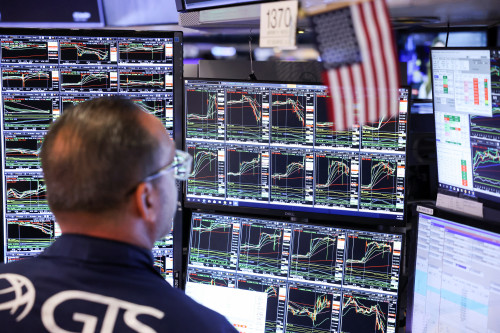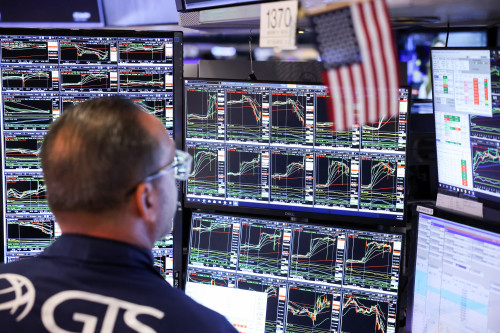By Suzanne McGee, Dhara Ranasinghe
NEW YORK/LONDON (Reuters) -Global markets are set for a fresh jolt on Monday after U.S. President Donald Trump launched a trade war with sweeping tariffs on Canada, Mexico and China that threaten to undermine economic growth and reignite inflation.
With Mexico and Canada – the top U.S. two trading partners – vowing immediate retaliation and China saying it would take “counter measures,” the scene was set for a round of turbulence.
Markets were dealt a blow last week as the emergence of China’s DeepSeek AI model hit tech stocks, and uncertainty around Trump tariffs has weighed on broader markets.
The White House has not yet published all the details of the tariff plan, leaving questions about their impact and duration.
The risk of a global trade war could hurt U.S. corporate profits and pressure inflation, potentially upending U.S. interest rate cut expectations, and further weaken currencies such as the Canadian dollar and China’s yuan.
“I do think the markets are going to react to this,” said Mark Malek, chief investment officer at Siebert Financial in New York. “Until now the market has really been on Trump’s side, but that could change and the market could challenge him for the first time.”
In three executive orders, Trump imposed 25% tariffs on Mexican and most Canadian imports and 10% on goods from China, starting on Tuesday.
Canada said it will respond with 25% tariffs against $155 billion of U.S. goods, beginning with $30 billion taking effect Tuesday and $125 billion 21 days later.
“It’s negative for CAD, MXN and CNH, as well as overall risk,” Nick Twidale, chief market analyst at ATFX Global in Sydney said referring to the Canadian, Mexican and Chinese currencies.
Twidale anticipates sizeable moves in currencies when Asian markets open after hopes for a reprieve were dashed.
Canada’s dollar has been in the firing line in recent days, hitting five-year lows around 1.459 per dollar last week.
Mexico’s peso would suffer a near-12% fall if the United States hits the country with 25% trade tariffs, JPMorgan estimated in a note published on Friday. The Mexican peso was trading at around 20.6 per dollar late Friday.
Analysts also expect some kind of selloff in stocks and other higher-risk assets when markets reopen on Monday.
Gene Goldman, chief investment officer at Cetera Financial Group, said the combination of high valuations, the impact of tariffs on inflation and the effects on Federal Reserve policy would contribute to declines.
With the S&P 500 near all-time highs, the index could move 3% to 5% in either direction in the short term, Evercore ISI strategists said in a note.
TARIFF PAIN
Barclays strategists previously estimated that the tariffs could create a 2.8% drag on S&P 500 company earnings, including the projected fallout from retaliatory measures from the targeted countries.
The executive order includes a provision for Trump to increase the size and scope of the tariffs if countries affected seek to retaliate.
Goldman Sachs economists have estimated that across-the-board tariffs on Canada and Mexico would imply a 0.7% increase in core inflation and a 0.4% hit to gross domestic product.
The bank said in a note on Sunday it expects to update those estimates, and predicted the measures would not be permanent.
“In light of their potential economic effects and the fact that the White House has set general conditions for their removal, we think it is more likely that the tariffs will be temporary but the outlook is unclear,” it said in a note.
The potential to drive up consumer prices is a particularly sensitive area for investors, who are worried about a revival in inflation causing the Federal Reserve to stop cutting rates.
The Fed last week paused its rate-cutting cycle, while Fed Chair Jerome Powell said officials were “waiting to see what policies are enacted” with the new president.
European Central Bank policymaker Klaas Knot said on Sunday he expects new tariffs will lead to higher inflation and interest rates in the U.S. that will likely weaken the euro.
Europe also faces the risk of U.S. tariffs.
“It’s only a matter of time before the EU is targeted,” said Marchel Alexandrovich, an economist at Saltmarsh Economics in London. “In the meantime, the fact that Canada is responding and putting up tariffs against U.S. goods is a sign of things to come and demonstrates the risks to global trade.”
(Reporting by Suzanne McGee and Isla Binnie in New York and Dhara Ranasinghe in London; Additional reporting by Lewis Krauskopf and Laura Matthews in New York and Tom Westbrook in Singapore ; Editing by Megan Davies, Daniel Wallis, Elisa Martinuzzi, Will Dunham and Ros Russell)


